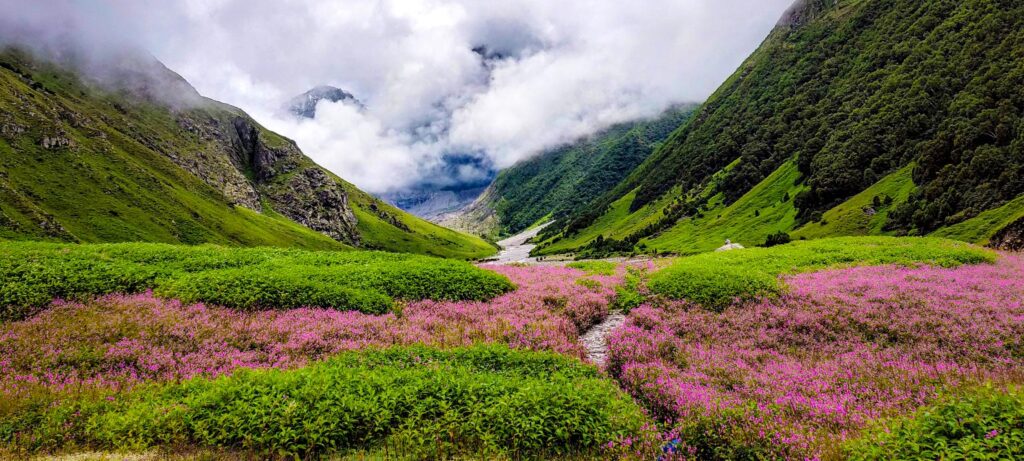The Valley of Flowers is one of India’s most breathtaking trekking destinations, renowned for its vibrant meadows of endemic flora and stunning landscapes. Below is a comprehensive guide to help you plan your adventure.
Introduction
The Valley of Flowers is a national park located in the Chamoli district of Uttarakhand, India. This UNESCO World Heritage Site is famed for its rich biodiversity and the spectacular array of wildflowers that bloom during the short summer season. Trekking here offers an unforgettable experience of nature’s brilliance set against the backdrop of the towering Himalayan peaks.
History and Significance
- UNESCO World Heritage Site: Recognized for its exceptional natural beauty and ecological significance.
- Biodiversity Hotspot: Home to a wide variety of flora and fauna, including rare and endangered species.
- Cultural Importance: The valley has historical links to local legends and is considered sacred by the inhabitants of the region.
Location and Geography
- Region: Chamoli district, Uttarakhand, India.
- Elevation: Ranges from about 3,500 to 6,000 meters above sea level.
- Landscape: Features lush meadows, cascading waterfalls, alpine flora, and rugged mountain terrains.
How to Reach
- Nearest Airport: Jolly Grant Airport in Dehradun.
- Nearest Railway Station: Rishikesh or Haridwar.
- Road Access: Regular bus services and taxis are available from major cities in Uttarakhand to Govindghat, the starting point of the trek.
- Trek Starting Point: Govindghat to Ghangaria, a small village that serves as the base camp for the trek.
Trek Itinerary
Day 1: Arrival at Govindghat
- Arrive at Govindghat by road from Rishikesh or Dehradun.
- Overnight stay in Govindghat.
Day 2: Govindghat to Ghangaria (13 km / 5-6 hours)
- Begin your trek from Govindghat.
- Enjoy the gradual ascent through scenic trails.
- Reach Ghangaria, where you can rest and acclimatize.
Day 3: Ghangaria to Valley of Flowers (3-4 km / 2-3 hours)
- Trek from Ghangaria to the Valley of Flowers.
- Spend time exploring the valley’s vast meadows and vibrant blooms.
- Return to Ghangaria for the night or camp in designated areas (if permitted).
Day 4: Return to Govindghat
- Trek back from Ghangaria to Govindghat.
- Depart for your onward journey to Dehradun or Rishikesh.
Best Time to Visit
- Peak Season: The valley is accessible from mid-July to mid-September, when the wildflowers are in full bloom.
- Weather Conditions: Summers are mild, but early monsoon days might be rainy. Always check local weather forecasts before planning your trip.
What to Pack
- Clothing: Layered clothing for variable weather conditions; include waterproof jackets and warm clothing for cooler evenings.
- Footwear: Sturdy trekking boots with good grip.
- Accessories: Sunhat, sunglasses, and sunscreen.
- Gear: Trekking poles, a first-aid kit, and a reliable backpack.
- Miscellaneous: Personal medication, water bottles, and energy snacks.
Accommodation and Facilities
- Ghangaria: Offers basic guesthouses, lodges, and campsites.
- Govindghat: Facilities available for an overnight stay before beginning the trek.
- Local Amenities: Limited medical facilities and small local eateries; consider carrying essential supplies with you.
Trekking Tips
- Acclimatization: Take your time to acclimatize to the altitude to prevent altitude sickness.
- Local Guides: Hiring a local guide can enhance your experience and ensure safety.
- Respect Nature: Follow park rules and guidelines to protect the delicate ecosystem of the valley.
- Plan Ahead: Secure necessary permits and check entry regulations for the Valley of Flowers National Park.
Conclusion
The Valley of Flowers Trek offers a unique blend of natural beauty, adventure, and spiritual rejuvenation. Whether you are a seasoned trekker or a nature enthusiast, this trek promises an unforgettable journey through one of India’s most stunning natural landscapes. Prepare well, respect the environment, and immerse yourself in the splendor of the Himalayan wilderness.
